class: center, middle 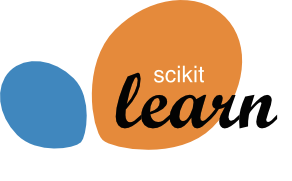 ### Introduction to Machine learning with scikit-learn # Introduction Andreas C. Müller Columbia University, scikit-learn .smaller[https://github.com/amueller/ml-workshop-1-of-4] --- # Other Resources .center[ 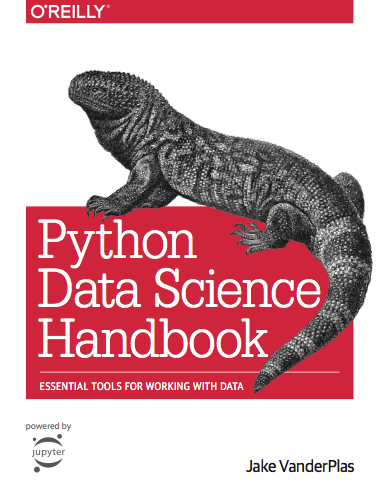 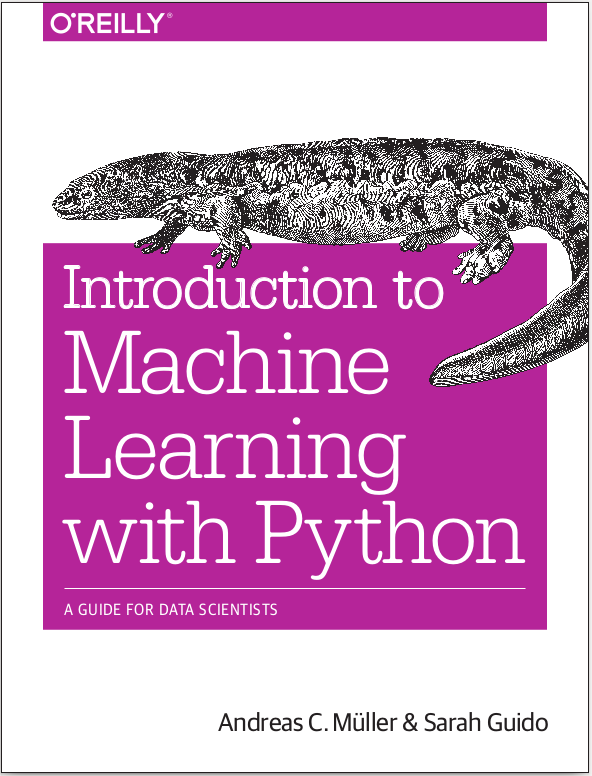  ] Lecture: http://www.cs.columbia.edu/~amueller/comsw4995s20/schedule/ https://www.youtube.com/andreasmueller Videos and more slides! ??? FIXME JAKE book border There are three books that I recommend looking into for this course. Definitely check out my book, Introduction to machine learning with Python. You can find the PDF on courseworks. My book should be a relatively easy read and it’s quite short. The second one is Applied predictive modelling by Max Kuhn, which goes a bit deeper. This is about the level I want to go to in this course. You can get it for free at springer link, I posted a link in courseworks. These two are really the essential ones. Finally, there's Elements of statistical learning, also known as ESL or the stanford book, by Hastie Tibshibani and Friedman is a classic for a more theoretical view. You can get it for free on the authors website. If you want to brush up on your Python skills, I also recommend the Python Data Science Handbook by my friend Jake Vanderplas. --- class: center, middle # What and Why of Machine Learning ??? I first want to talk about what is machine learning, and why do we want it. As you’re in this course, you’re probably already somewhat convinced that it’s useful, but I briefly want to give my own perspective. In general, today will not be very meaty and be more a loose collections of ideas and directions. The next class we will go down to the metal much more. --- class: center, middle # What is machine learning? ??? Machine learning is about extracting knowledge from data. It is closely related to statistics and optimization. What distinguishes machine learning is that it is very focused on prediction. We want to learn from a large dataset how to make decisions for future observations. You could say that the input to a machine learning program is the dataset, and the output is a program that can make decisions on future observations. Machine learning is really widely used now, and I want to give you some examples that most of you probably already interacted with today. --- .center[  ] ??? Here’s the Facebook news-feed. There’s so much machine learning here, it’s crazy. Can you point out some of them? So the most space is a sponsored item. Facebook used ML to know who to show this too. It’s clearly targetted at developers. Facebook also used ML to know how much to charge for showing it. Then there’s a post below by a friend. Facebook ranked that top most interesting to me right now, again ML. Then on the right, you can see birthdays. It shows only one name, though there’s two birthdays. Again ML to decide how many and whom to show. Below, trending topics, apps to connect and people I might now. All ML. --- .center[  ] ??? But wait, there’s more. Here’s me uploading a picture. It finds the faces of many of the people here, even in odd poses. Not only my friend Gael here, one of the creators of scikit-learn, but also Jared Lander there in the background. I'm pretty sure they could automatically tag the people, and actually describe the photos, but that seems to be disabled on my account. My account might still be European, where they don't tag faces because of privacy concerns. --- .center[  ] ??? And then after you post an album, facebook will select some most interesting pictures for you, and give them different kinds of space, to create a mosaic. But that’s just facebook. Let’s see what else I’ve got open. --- .center[ 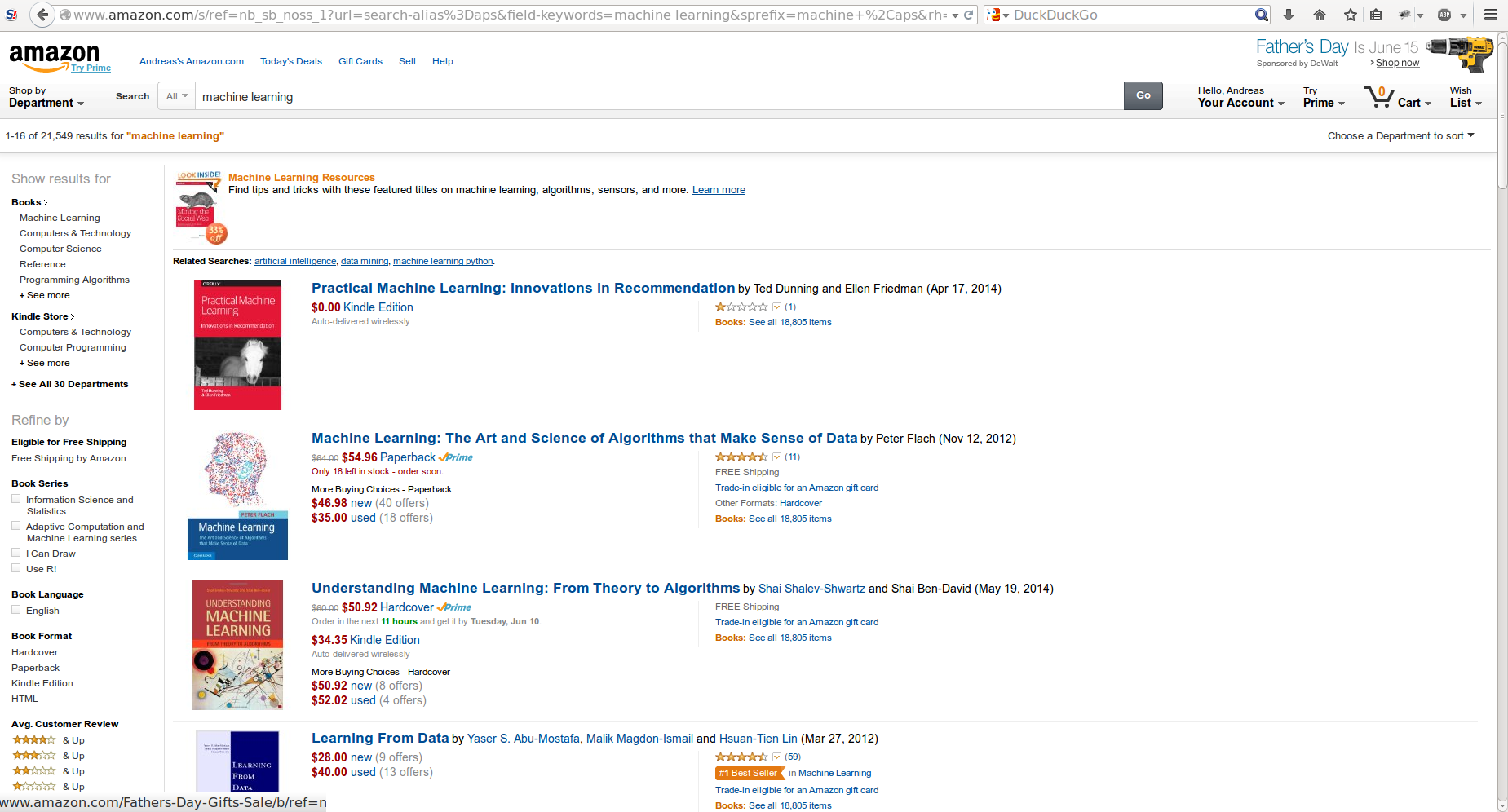 ] ??? And then as a last example, amazon. Because google would have been too easy. Here I’m searching for machine learning. I get a ranked list, using machine learning. I get sub-categories to search in, via machine learning. Each book has some features, like top seller etc, added with machine learning. And there’s an ad at the top, selected via machine learning. --- .center[ 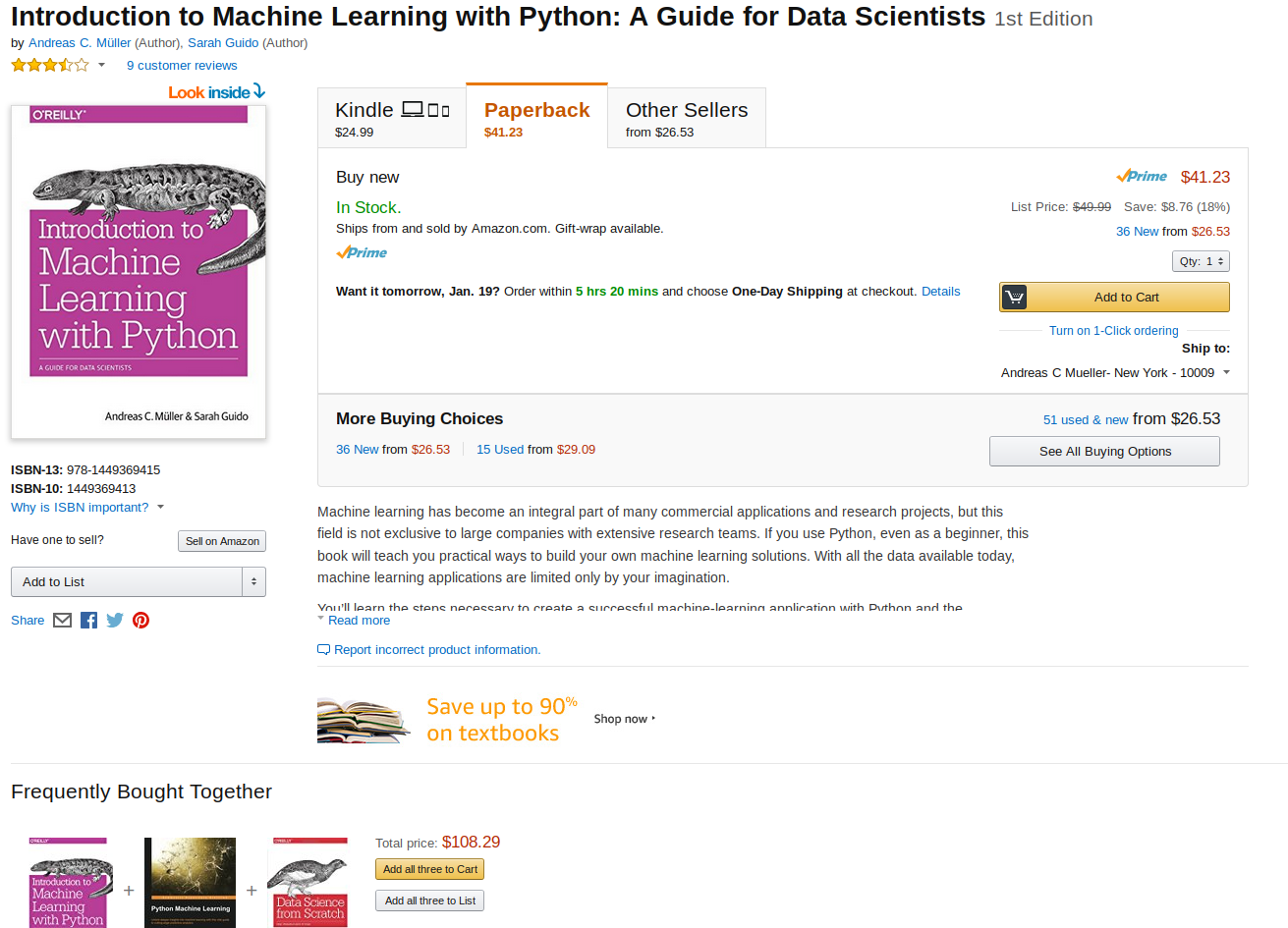 ] ??? And if I click on a book, more machine learning. There’s an ad below for textbooks, targetted to me. There’s paperback as the default choice, again machine learning. There’s frequently bought together, and maybe less obviously, there’s a default seller! The price that is shown on the right that’s selected for “add to cart” is also selected from a whole pool of possible amazon sellers via machine learning. Ok, that’s enough websites I think. While I went through all this, you were probably on your phone, looking at more output produced by machine learning. My point is, it’s everywhere. And often non-obvious, as in the case of selecting a seller here. --- # Science! .center[  ] ??? That was some of the flashy, every day live applications. Something that might get you VC funding. There’s also a lot of machine learning applications in less visible, but equally important - or more important - applications in science. There is more and more personalized cancer treatment – via machine learning. More medical diagnosis, and more drug discovery are using machine learning. The higgs boson couldn’t have been found without machine learning, and the same is true for many earth like planets in other solar systems. Which is shown using an artists illustration here. In reality you would have a single pixel, containing the sun and the planet. You can find exoplanets by checking whether the star gets periodically slightly darker, in which case you found a planet. Of course with machine learning! Machine learning is an essential in many data driven sciences now! So no matter where you want to go with data, you need machine learning. But what does that mean? Next, I want to give you a little taxonomy of machine learning methods. --- class: center, middle # Types of Machine Learning ??? There are three main branches of machine learning. Who can name them? --- class: spacious # Types of Machine Learning - Supervised - Unsupervised - Reinforcement ??? They called supervised learning, unsupervised learning and reinforcement learning. What are they? This course will heavily focus on supervised learning, but you should be aware the other types and their characteristics. We will do some unsupervised learning, but no reinforcement learning. Supervised learning is the most commonly used type in industry and research right now, though reinforcement learning becomes increasingly important. --- class: center # Supervised Learning .larger[ $$ (x_i, y_i) \propto p(x, y) \text{ i.i.d.}$$ $$ x_i \in \mathbb{R}^p$$ $$ y_i \in \mathbb{R}$$ $$f(x_i) \approx y_i$$ ] ??? In supervised learning, the dataset we learn form is input-output pairs (x_i, y_i), where x_i is some n_dimensional input, or feature vector, and y_i is the desired output we want to learn. Generally, we assume these samples are drawn from some unknown joint distribution p(x, y). In statistics, x_i might be called independent variables and y_i dependent variable. What does iid mean? We say they are drawn iid, which stands for independent identically distributed. In other words, the x_i, y_i pairs are independent and all come from the same distribution p. You can think of this as there being some process that goes from x_i to y_i, but that we don’t know. We write this as a probability distribution and not as a function since even if there is a real process creating y from x, this process might not be deterministic. The goal is to learn a function f so that for new inputs x for which we don’t observe y, f(x) is close to y. This approach is very similar to function approximation. The name supervised comes from the fact that during learning, a supervisor gives you the correct answers y_i. --- # Generalization .padding-top[ .left-column[ Not only also for new data: ] .right-column[$f(x_i) \approx y_i$, $f(x) \approx y$ ]] ??? For both regression and classification, it’s important to keep in mind the concept of generalization. Let’s say we have a regression task. We have features, that is data vectors x_i and targets y_i drawn from a joint distribution. We now want to learn a function f, such that f(x) is approximately y, not on this training data, but on new data drawn from this distribution. This is what’s called generalization, and this is a core distinction to function approximation. In principle we don’t care about how well we do on x_i, we only care how well we do on new samples from the distribution. We’ll go into much more detail about generalization in about a week, when we dive into supervised learning. --- class: spacious # Examples of Supervised Learning - spam detection - medical diagnosis - ad click prediction ??? Here are some examples of supervised learning. Given an array of test results from a patient, does this patient have diabetes? The x_i would be the different test results, and y_i would be diabetes or no diabetes. Given a piece of a satellite image, what is the terrain in this image? Here x_i would be the pixels of the image, and y_i would be the terrain types. This is often used to automate manual labor. For example, you might annotate part of a dataset manually, then learn a machine learning model from this annotations, and use the model to annotate the rest of your data. --- # Unsupervised Learning .padding-top[ $$ x_i \propto p(x) \text{ i.i.d.}$$ Learn about $p$. ] ??? In unsupervised machine learning, we are just given data points x_i, that are assumed to be drawn from an unknown distribution. Usually we want to learn something about these, such as whether they lie on a low-dimensional subspace, or whether the data clusters in several groups, or find ways to represent the distribution compactly. The goal in unsupervised learning is often much less clear than in supervised learning, and there is no-one providing a “correct” answers and no supervisor. Common examples of unsupervised learning is discovering topics in news articles or on twitter, or grouping data into clusters for easier analysis. Another one is outlier detection, where you ask “does this data look normal” which is important for fraud detection and security systems. --- class: center, spacious # Reinforcement Learning .left-column[ 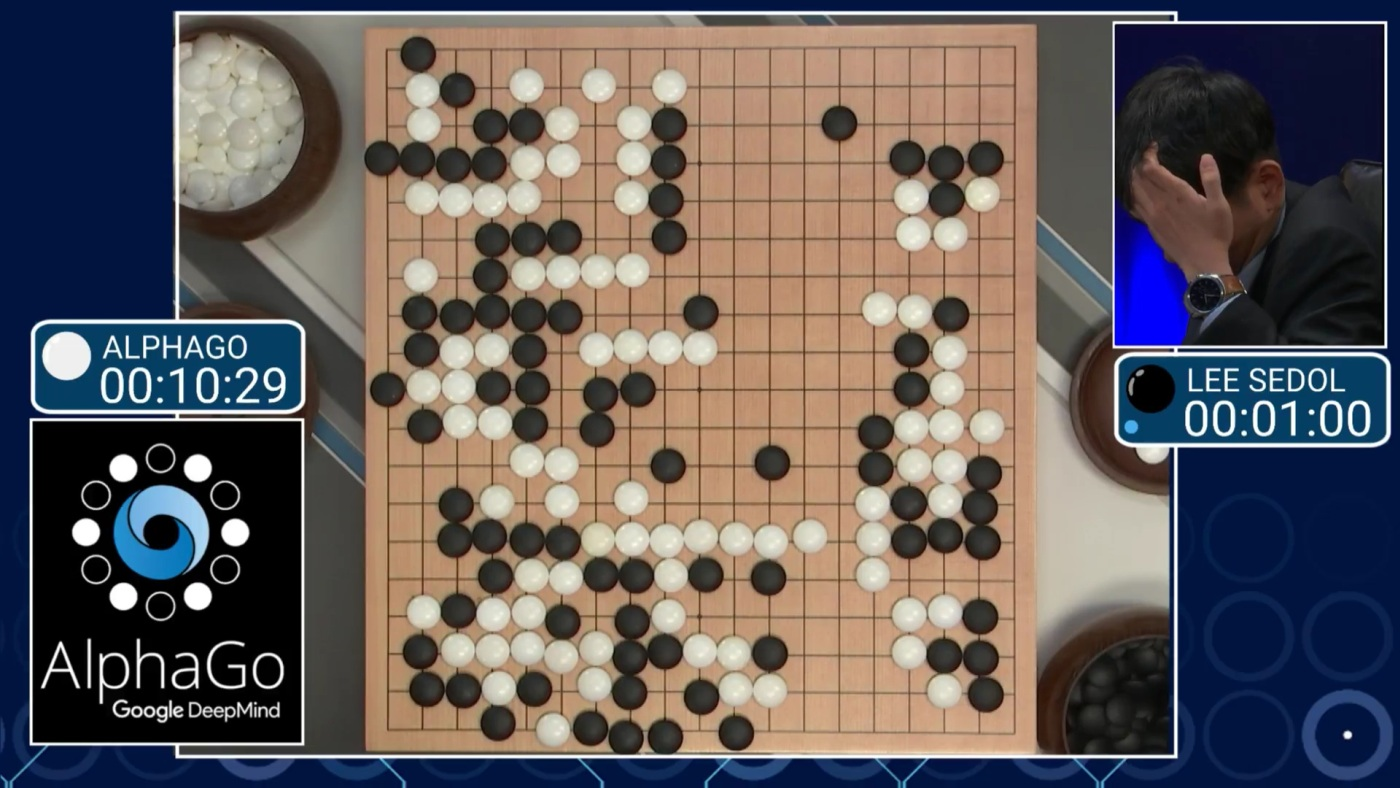 ] .right-column[  ] ??? The third kind, reinforcement learning, has been in the news quite a bit in the last year. Has anyone heard of that? Alpha go beat the world champion in go. Reinforcement learning is about an agent learning to interact with an environment, with some ultimate goal. The environment could be a go board, and the goal to win the game. For self-driving cars, the the environment could be roads, sensed by cameras and laser sensors, and the goal would be to get you somewhere quickly and safely. Or, the environment could be a social media platform, and the goal could be to provide you such great content that you never remove your eyes from your phone again! --- class: spacious # Explore & Learn .center[ 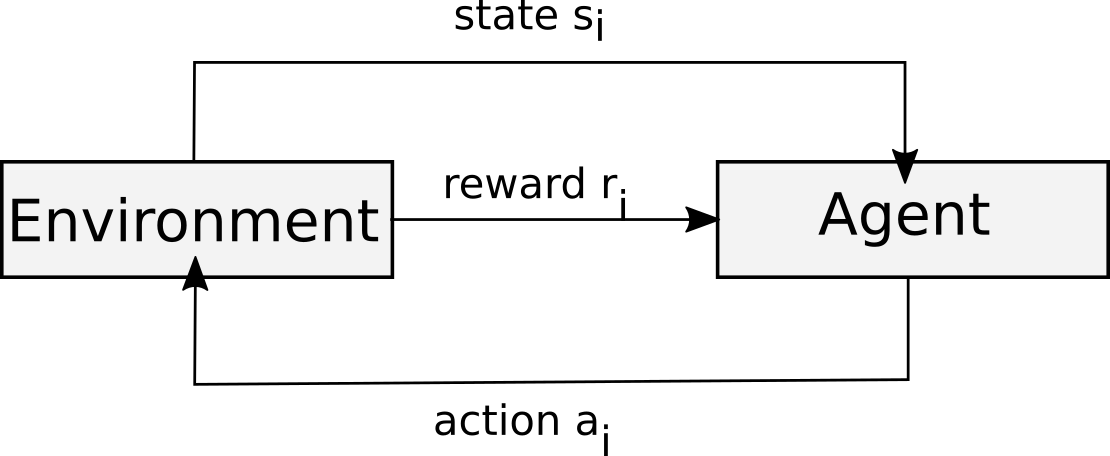 ] ??? Reinforcement learning is quite different in that you usually don’t work with a dataset – you work with a whole world. This can be a video game, a simulation, or the real world. The actions of the agent influence which part of the world they see and which situations they encounter, and it’s usually impossible to look at all possible situations, even for something as limited as a go board. This means in reinforcement learning you can not separate data collection and learning, which you can do for unsupervised and supervised learning. There will be no reinforcement learning in this class, as the techniques are quite different, and real-world use of this technique is still quite limited. --- # Other kinds of learning - Semi-supervised - Active Learning - Forecasting - ... ??? There are other kinds of learning that are somewhere between the three kinds I just explained. Semi-supervised learning for example is a combination of supervised and unsupervised learning. Active learning is somewhere between reinforcement learning and supervised learning. There are also many kinds of supervised learning where the assumption that data points are independent is dropped, for example for time series analysis and forecasting. However, if you get the three main concepts, the rest will be easy to understand. Some people, including the local and famous Yann LeCun think that supervised learning is fundamentally limited. In particular it doesn’t seem to be how humans learn. So now you can buy these shirts on redbubble --- # Classification and Regression .left-column[ ### Classification - target y discrete - Is this patient sick? ] .right-column[ ### Regression - target y continuous - How long will it take for the patient to recover? ] ??? So getting back to supervised learning, there are two basic kinds, called classification and regression. The difference is quite simple: if y is continuous, then it’s regression, and if y is discrete, it’s classification. While it's simple, let me give an example. If I want to predict whether a one of you will pass the class, it’s a classification problem. There are two possible answers, “yes” and “no”. If I want to predict how many points you get on an exam, it’s a regression problem, there is a continuous, gradual output space. There are generalizations of this where we try to predict more than one variable, but we won’t go into that in this course. The main reason the distinction between classification and regression is important is because the way we measure how good a prediction is is very different for the two. It's not always entirely clear whether it's best to formulate a problem as classification or regression. If you think of predicting a 5-star rating, there's only 5 different possible outcomes, so you might think it's classification. But there is also an obvious ordering between the outcomes, which would make it a regression problem. Both formulations could work, and there are approaches that combine the two for this particular problem. --- # Relationship to Statistics .left-column[ ### Statistics - model first - inference emphasis ] .right-column[ ### Machine learning - data first - prediction emphasis ] ??? Before I’ll go into some general principles, I want to position machine learning in relation to statistics. I recently got chewed out by a colleague for doing that. My goal here is not to say one is better than the other. Actually, there’s really no clear boundary between statistics and machine learning, and anyone that tells you otherwise is lying. Two of the books I recommended for the course are actually statistics text books. But I can tell you how the tools that I’m talking about in this course will differ from what you’d learn in a typical stats course. Statistics is usually about inference, often phrased in terms of hypothesis testing. An example might be a yes-no-question, such as “are women less likely to enroll in a Data Science Program”, and you have a sample population, for example this classroom, and you can then try to make an inference about whether this statement is true. Often this includes making assumptions on how your sample relates to the general population, say this class vs all of DSI or Columbia vs all of the US. You might also have a specific model of how the process behind your question works. --- # Relationship to Statistics .left-column[ ### Statistics - model first - inference emphasis ] .right-column[ ### Machine learning - data first - prediction emphasis ] ??? On the other hand, machine learning is about prediction and generalization. We want to learn from past data to predict outcomes on future, unseen data. We usually want to make statements about individual data points, and we want to build a model that will work on new data that fulfills our assumptions, independent of the population we samples. Often we don’t have or need a model of the process, but we rely on the assumption that our training data is generated from the same process as any future data will be. There are statisticians that do predictions and there are machine learning scientists that do inference, but I find this distinction helpful. Again I’m not saying one or the other is better, I’m just saying that you should know what kind of problem you are trying to solve, and what the right tool for the problem is. And then you can call it machine learning or statistics or probabilistic inference or data science. The tools you learn in this class will usually not help you to make yes/no inferences, and they will only give you a limited insight into the data generating process. --- class: middle # Guiding Principles in Machine Learning ??? For the rest of todays lecture, I want to talk about some guiding principles in machine learning applications, and they will hopefully be something you’ll come back to later. We will revisit some of them at the very end of the semester in more detail. --- class: middle # Goal considerations ??? One of the most important parts of machine learning is defining the goal, and defining a way to measure that goal. In this way, Kaggle is a really bad way to prepare you for machine learning in the real world, because they already did that work for you. In the real world, people don’t tell you whether you should use unsupervised learning, supervised learning, classification or regression, and what’s the right way to cast something as a machine learning task – or whether to cast it as machine learning at all. --- class: middle # The Cost of Complex Systems ## Data driven first? yes! (or maybe) ## Machine Learning first: No! ??? My first advice would be, don’t try machine learning. Machine learning systems are very complex and often fragile. Whether you’re in research or a startup, don’t immediately start with "oh we can apply deep learning to this". Often it’s good to collect data, and be able to use data to drive and evaluate decisions. But including a complex process like machine learning into whatever you’re trying to do will make it much harder to debug and much harder to understand. --- class: middle # Thinking in Context! # What is the baseline? # What is the benefit? ??? So think in context of your problem. What do you want to achieve? What is the easiest way to achieve this? And what will improving over this baseline buy you? Let’s go through an example: Imagine you had an electronics store, but you realized retail is all digital and you’re closing your store with one big sale to move on. You want to do an email campaign to tell all your customers about the sale. Is there a machine learning application here? You could try A/B testing the email message. But that will only work if you have many many customers. You could use ML to predict which customers might respond. How do you get the data? Let’s say you have data. What’s the benefit? None! This is your closing sale. You’ll never email them again. It doesn’t matter if they’ll include you in your spam filter. Just email everybody! --- class: middle # Communicating Results ??? Another very important aspect of machine learning is to be able to communicate results, and to be able to explain methodologies. If you’re want to use machine learning in research that's not computer science, you need to be able to explain why it works. If you automatically make some decisions in your business applications, you need to convince your boss that nothing crazy will happen. How do you do that? It’s an important skill to explain what particular results mean, what their impact will be, and how often a method will work or fail. Only if you can convince your manager your approach is sensible will your system go to production. --- class: middle, center # Explainable Results  ??? Sometimes, you even need to explain to the user why you made a decision. People found that recommendation engines work much better if the users are shown a reason for a particular recommendation. Netflix tells you based on what show it recommends another show, Amazon does the same for products. Interestingly, this also works even if the explanation is not true. There are systems that make a recommendation, and then provide a believable “explanation” after the fact. That gets more engagement than just providing the recommendation, though some people might question the ethics of that. Earlier I said in ML we are just interested in good predictions. If you need to be able to explain your predictions, this is no longer true. --- class: middle, center # Sidebar: Ethical Considerations <br/> .compact[https://www.propublica.org/article/machine-bias-risk-assessments-in-criminal-sentencing] ??? There is another area where explainability and transparency matter, and that is when people’s lives are at stake. One aspect of machine learning that only recently is getting some more attention is ethics. There was a recent article in propublica about racial bias in risk-assessment used in the criminal justice system. Spoiler alert: it’s bad. I recommend reading the article, it’s quite interesting. This is a black-box machine learning system created by some company. If they had to provide explanations, or a more transparent system, the situation would likely be better. But this is not the only place where ethics plays a role in machine learning.